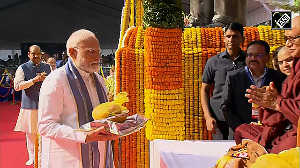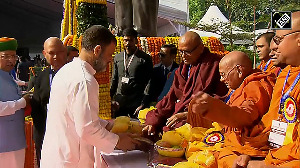 To read Raymond Vickery's hugely interesting book while US Secretary of State Hillary Clinton is still on Indian soil reminds one of the great distance India and the US have travelled since the 1998 nuclear tests, writes Jyoti Malhotra.
To read Raymond Vickery's hugely interesting book while US Secretary of State Hillary Clinton is still on Indian soil reminds one of the great distance India and the US have travelled since the 1998 nuclear tests, writes Jyoti Malhotra.Clinton's husband, then president Bill Clinton, himself a votary of using economics to motivate the political relationship, couldn't stop economic sanctions from automatically kicking in and Madeleine Albright, then secretary of state and at present a colleague of Vickery (they work together in the lobbying group Albright Stonebridge), famously declared, 'India has dug itself into a big hole.'
Barely a decade later, the Indian-American community as well as US business with an eye on India (notably, Warburg Pincus with its $400 million investment into the Bharti Mittal empire) was pushing the Bush administration to cut a nuclear deal with India.
This would lift high-technology sanctions and galvanise the business-to-business relationship, the real lubricant to completing the strategic circle.
A former assistant secretary of state for commerce, Vickery's book rests on the belief that economic engagement drives political strategic cooperation.
In an interview in Delhi on Monday, Vickery agreed that despite the path-breaking nuclear deal which was passed in the dying days of the Bush administration in 2008, things had come to such a pass today that both sides seemed to be questioning the way forward.
"If we're not moving forward, we're moving backward," said Vickery. He noted that a free trade agreement in information technology and attendant services such as innovation could be one such big idea to drive the relationship in the near future, since both countries had proven reserves in IT resources.
Vickery's impassioned plea is based on a ringside view of US economic engagement that has driven political ties, at least since Bill Clinton's first presidency.
Vickery was a close associate of then commerce secretary Ron Brown, who tragically died in a plane crash in Dubrovnik in the Balkans, and he tells the story in this book to exemplify how US business never hesitated to share the goals of its political masters; seems, the expedition that returned to the Balkans immediately after Brown's accident was full of top businessmen, several of whose companies had lost senior executives in the crash that killed Brown.
It is this kissing distance between business and government that Vickery believes is the glue that drives strategy (Indian businessmen could sit up and take a leaf out of this commitment).
Not for him the bureaucratic separation of powers both in India and the US, between the commerce and foreign ministries --
If you have to think big, argues Vickery, governments must not shy away from the profit motive.
He notes that in the wake of the Mumbai attacks in November 2008, then home minister P Chidambaram's first stop in Washington DC was to meet several US agencies that were created to combat terror.
It seems that at least some of the Indian government's $400 million (or so) budget to improve its own systems has been spent on procuring US equipment for its own homeland security.
Vickery's excellent book takes a look at the bilateral relationship through eight case studies.
These include not only the failure of the Dabhol-Enron power plant to propel a breakthrough in clean technologies, but also in the success areas of food security, in the joint fight against HIV-AIDS and so on.
The story of the H1-B visa and its political context in both countries makes for gripping reading.
A compelling chapter in the book is Vickery's reconstruction of the prickly Iran-India-US relationship, in which several US Congressmen, notably Tom Lantos, then chairman of the US House of Representatives, threatened to stop the nuclear deal in its tracks if Delhi continued to look towards Teheran in its search for energy security.
Not since Dennis Kux wrote Estranged Democracies in the mid-90s has a book like this one explained the Indo-US relationship with all its complexities.
What makes it even more interesting is the accompanying colour -- how Tom Lantos, the only Nazi survivor in the US Congress, was stroking his little dog when Vickery went to meet him; how Henry Reid showed him a small statue of Mahatma Gandhi gifted to him by his Indian-American friends in the years when they were all much poorer.
There isn't that much about India's chief rival, China, in the book, except for passing references to Bill Clinton's determination to separate the economic engagement with the political one and George Bush's subsequent distaste for Beijing which helped push ties with India.
"In India, people often ask why China gets so much attention in the US. It's obvious, just look at the Sino-US trade figures, they are more than three times that of India," Vickery said.
The Eagle And The Elephant: Strategic Aspects of US-India Economic Engagement
Raymond E Vickery
Oxford University Press
284 pages; Rs 695













 © 2025
© 2025